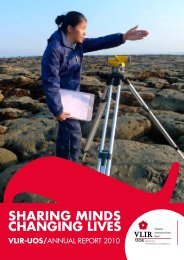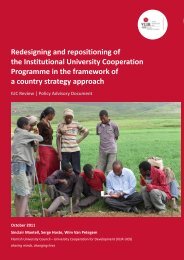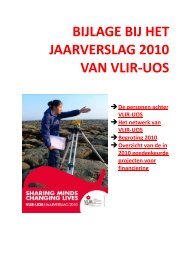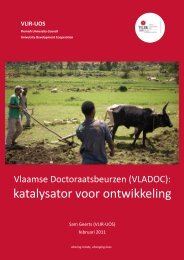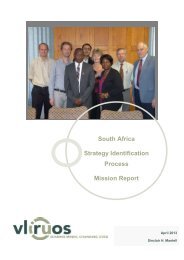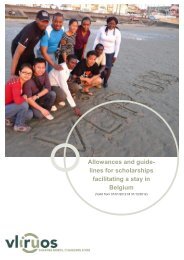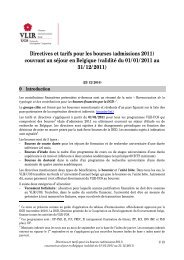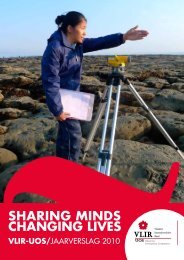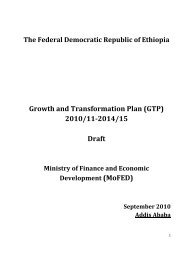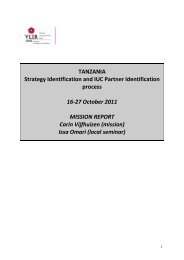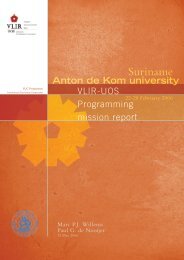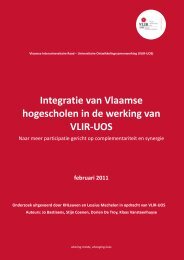Education Sector Development Program - VLIR-UOS
Education Sector Development Program - VLIR-UOS
Education Sector Development Program - VLIR-UOS
You also want an ePaper? Increase the reach of your titles
YUMPU automatically turns print PDFs into web optimized ePapers that Google loves.
<strong>Education</strong> <strong>Sector</strong> <strong>Development</strong> <strong>Program</strong> IV<br />
❚<br />
❚<br />
❚<br />
primary education and when /<br />
wherever necessary through ABE<br />
centers<br />
General secondary education<br />
expanded in view of its<br />
universalization by 2025 in line with<br />
the Middle Income Country Vision<br />
Equitable access to quality primary<br />
and secondary education expanded<br />
amongst the four emerging regions<br />
and the gap between the emerging<br />
regions and other regions reduced, by<br />
giving special support to the education<br />
of emerging regions’ children (both<br />
female and male)<br />
Capacity of educational management<br />
bodies at various levels strengthened<br />
❚ 95% of adult illiterates will participate<br />
in a two-year FAL program.<br />
For TVET, the goal is to create a competent,<br />
motivated, adaptable and innovative workforce<br />
and to transfer accumulated and demanded<br />
technologies in Ethiopia, thus contributing to<br />
poverty reduction and social and economic<br />
development through facilitating demand-driven,<br />
high quality technical and vocational education<br />
and training, relevant to all sectors of the<br />
economy, at all levels and to all people.<br />
Some key outcomes for TVET are:<br />
❚<br />
❚<br />
Quality of TVET (formal and nonformal)<br />
improved at all levels and<br />
made responsive to the needs of the<br />
labor market<br />
A comprehensive, integrated, outcome<br />
based and decentralized TVET system<br />
for Ethiopia established<br />
❚ Number of rich/advanced Medium and<br />
small enterprises created through the<br />
transferred technologies.<br />
For higher education, the goal is to develop<br />
highly qualified, motivated and innovative human<br />
resources and produce and transfer advanced<br />
and relevant knowledge for socio-economic<br />
development and poverty reduction with a view to<br />
turning Ethiopia into a middle-income country by<br />
the year 2025.<br />
Some key outcomes for higher education are:<br />
❚<br />
❚<br />
A balanced distribution of higher<br />
education opportunities throughout<br />
the country through the widening<br />
of access to higher education, in<br />
particular to science and technology<br />
Increased student learning, personal<br />
growth and improved employability<br />
through high quality higher education<br />
and relevant professional mix<br />
of particular importance: Capacity development<br />
for improved management; Gender and<br />
education; Special needs education; HIV/AIDS<br />
and education; Environmental education and<br />
protection; <strong>Education</strong> in emergencies; School<br />
health and nutrition; and Drug and substances<br />
abuse prevention in education.<br />
The Monitoring and Evaluation Framework<br />
ensures a focus on outcomes and proposes<br />
mechanisms which will help the coordination<br />
between federal, regional and woreda levels.<br />
The overall cost of ESDP IV is around 140 billion<br />
Birr. 71.2% of the cost goes to recurrent spending<br />
and 28.8% for capital spending. About 37% of the<br />
program costs are for primary level, 11.2% for<br />
secondary education, 8.8% for adult education<br />
and some 21.7% dedicated to higher education.<br />
The relatively limited spending on TVET (8.0%) is,<br />
to a large extent, due to the important share of<br />
students expected to enroll in non-government<br />
schools. Spending on administration, advisory<br />
and support services is estimated at 7.2%.<br />
The table hereunder presents the indicative<br />
financing plan, with a financing gap for each of<br />
the five years of ESDP IV, which compares the<br />
overall cost with the government contribution.<br />
Estimated financing gap for ESDP IV (in<br />
million Birr)<br />
2010/11 2011/12 2012/13 2013/14 2014/15 Total<br />
a. Estimated<br />
<strong>Education</strong> budget<br />
18 286 19 748 21 802 24 113 26 742 110 691<br />
b. Projected costs 20 547 28 230 28 638 31 794 31 418 140 627<br />
Gap (a-b) -2 261 -8 482 -6 836 -7 681 -4 676 -29 936<br />
The financing gap is estimated on the basis of<br />
assumptions about economic growth and about<br />
shares of education in the budget. The gap may<br />
be filled up in different ways. Among these we can<br />
mention: economic growth above the assumed<br />
rate; an increase in the share of education in<br />
the budget; support by development partners;<br />
an increase in the contributions by communities<br />
(for instance for salaries of some non-teaching<br />
staff or for construction of selected facilities); a<br />
stronger reliance on cost-recovery, especially at<br />
higher levels of the educational system.<br />
Eight crosscutting issues aim to focus attention<br />
on the situation of specific groups and on issues<br />
9



